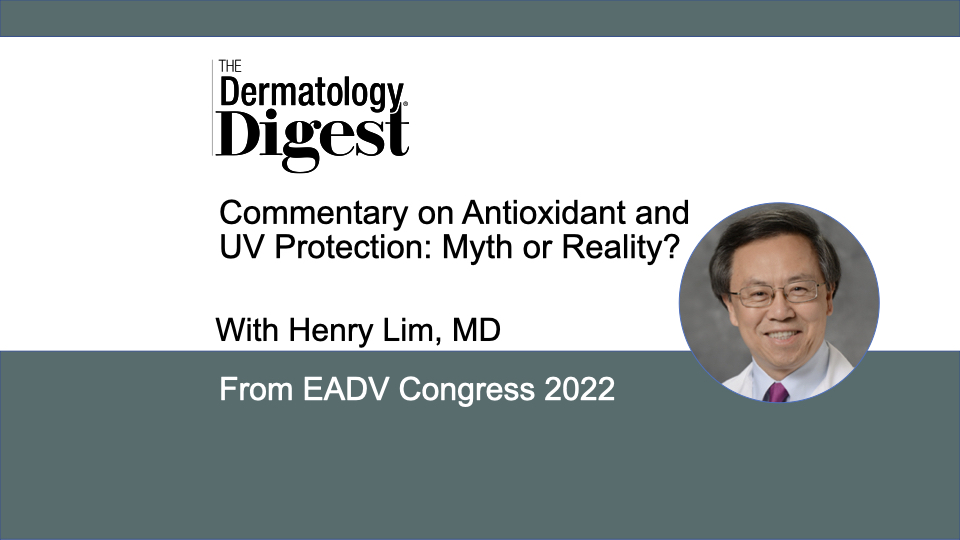Dr. Henry Lim discusses the benefits of antioxidants in sunscreens, including recent research on their biologic properties and role in photoprotection.
Henry Lim, MD, former chair, Department of Dermatology, Henry Ford Health, Detroit, Michigan
“About 10 years ago, there was a study by Steven Wang1 to look at sunscreens that were then available that contained antioxidants. The study was to see how active those antioxidants were in terms of biologic activities, and essentially what he found is that many of them have no biologic activities,” said Henry Lim, MD, who presented “Antioxidant and UV Protection: Myth or Reality?” at the 31st EADV Congress 2022 in Milan, Italy.
“Since then, significant progress has been made by industry. Nowadays, there are antioxidants incorporated into sunscreen that have biologic activities. What I mentioned in the presentation is that there is a biologic rationale for antioxidants to serve as part of the photoprotective effects that we all would need.”
Putting biologically active antioxidants on top of the skin helps to “quench,” or neutralize, the activity of the reactive oxygen species,2 said Dr. Lim.
“Specifically, we know that ultraviolet light, especially ultraviolet A, can induce the generation of reactive oxygen species. We also know that visible light can also induce the generation of reactive oxygen species. The presence of antioxidants would then make the reactive oxygen species generated to be less damaging to the skin.”
Suppressing Pigmentary Alteration
This knowledge leads to a new level of understanding for photoprotection, said Dr. Lim.
“…we do know that ultraviolet A rays, especially the long wave ultraviolet A, do induce significant tanning reaction on the skin. We also know that visible light, especially the shorter wavelength visible light, would induce also very significant pigmentary darkening on the skin.”3
And the effect of visible light is especially noticeable on dark skin individuals compared to light skin individuals, he said.
“And this is exactly the population where many of the pigmentary alterations on the skin would occur following sun exposure.”
Pigmentary alterations include melasma, blotchy brown discoloration, and post inflammatory hyperpigmentation, which can last nearly a year after acne, he said.
“Those are very significant problems for dark skin individuals. So, that is when the role of some of the newer photoprotective agents comes in, including antioxidants.”
According to Dr. Lim, studies he presented at the EADV meeting showed that sunscreen plus antioxidant formulations help to suppress pigmentary alteration caused by visible light.4
“Therefore, it has a protective effect.”
However, standard sun-safe practices still stand, he said.
“Proper photoprotection is the entire package of staying in the shade when outdoors, putting on appropriate clothing and hats, and applying sunscreen on exposed areas. The incorporation of antioxidants in sunscreens is another adjunctive step that is available to help to protect the skin from the side effect of sunlight, in this particular case, the visible light.”
In another study, oral Polypodium leucotomos, which has antioxidative properties, also helped to suppress the visible light-induced alterations of skin pigmentation, noted Dr. Lim.
“So bottom line is that in terms of the antioxidants, based on what we know of their biologic properties, the fact that technology has advanced now that industry can incorporate biologically active antioxidants into the sunscreen, together with new knowledge about the effect of visible light, there is a role for antioxidants in photoprotection.”
References:
- Chen LL, Wang SQ. From the bottle to the skin: challenges in evaluating antioxidants. Photodermatol Photoimmunol Photomed. 2012 Oct;28(5):228-34. doi: 10.1111/j.1600-0781.2012.00674.x. PMID: 22971186.
- Lim HW, Kohli I, Ruvolo E, Kolbe L, Hamzavi IH. Impact of visible light on skin health: The role of antioxidants and free radical quenchers in skin protection. J Am Acad Dermatol. 2022 Mar;86(3S):S27-S37. doi: 10.1016/j.jaad.2021.12.024. Epub 2021 Dec 20. PMID: 34942294.
- Ruvolo E, Boothby-Shoemaker W, Kumar N, Hamzavi IH, Lim HW, Kohli I. Evaluation of efficacy of antioxidant-enriched sunscreen products against long wavelength ultraviolet A1 and visible light. Int J Cosmet Sci. 2022 Jun;44(3):394-402. doi: 10.1111/ics.12785. Epub 2022 Jun 17. PMID: 35587114.
- Lyons AB, Zubair R, Kohli I, Nahhas AF, Braunberger TL, Mokhtari M, Ruvolo E, Lim HW, Hamzavi IH. Mitigating Visible Light and Long Wavelength UVA1-induced Effects with Topical Antioxidants. Photochem Photobiol. 2022 Mar;98(2):455-460. doi: 10.1111/php.13525. Epub 2021 Oct 4. PMID: 34549819.


